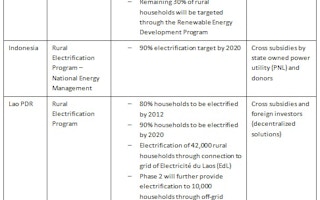UN Secretary-General Ban Ki Moon launched the “Sustainable Energy for All” Initiative early this year. This is a timely reminder to Asean countries to put rural electrification back on the energy agenda.
The Initiative brings business, governments, investors, community groups and academia to the table to support three inter-linked objectives. These include ensuring universal access to modern energy services, doubling the rate of improvement in energy efficiency, and doubling the share of renewable energy in the global energy mix.
The rapidly developing Southeast Asian region is characterized by increasing energy demand, but at the same time it is plagued by growing environmental pressures, low rural electrification levels, and a heavy reliance on fossil fuels and traditional biomass.
Asean’s primary energy requirement is projected to triple between 2005 and 2030, having already more than doubled between 1990 and 2007 - with an annual growth rate of 4 per cent (double the world’s average). Therefore, meeting the region’s energy needs, which will usher in unprecedented increases in coal use, oil and gas imports and greenhouse gas emissions, will prove to be a challenge. One of three energy resource-rich regions in Asia, alongside oil-rich Middle-East and the emerging energy-filled Central Asia, Asean produces and consumes its own energy resources while marketing and processing energy sources for major economies like China, Japan and South Korea. It also possesses a strategic waterway through which 80 per cent of East Asia’s energy passes.
There is considerable coal and gas in the region, but more will need to be imported. Although resource endowments vary substantially from country to country in this unique region, large potentials for renewable energy sources remain untapped.
To address energy poverty matters, governments must encourage off-grid use of renewable energy to help advance rural electrification and meet socio-economic development objectives. The long term success of their initiatives will require viable, self-sustaining technological and financial models that engage the poor communities they are designed to help.
Despite the slow uptake of off-grid renewable energy projects in Asean, all hope is not lost. Thailand’s remarkable success in delivering electricity access through its 1974 National Plan for Accelerated Rural Electrification Program in just 20 years is a good example of government effort in maximizing potential benefits while minimizing project cost. The program integrated rural electrification into a broader national development strategy while giving consideration to the social and political requirements of less stable areas.
Similarly, the achievements of the Philippines rural electrification program, which succeeded in bringing electricity to 4.5 million households in 30 years, have been impressive.
Home to 567 million people in 10 member states, Asean has a startling 160.3 million people without electricity, according to IEA’s 2008 estimates. Rural electrification rates range widely throughout the Asean region, from 10 per cent in Myanmar to 100 per cent in Singapore.
CountryElectrification Rate (%)Millions TotalUrbanRuralPopulation without electricityBrunei99.7100.098.60.0Cambodia24.066.012.511.2Indonesia64.594.032.081.1Laos55.084.042.02.7Malaysia99.4100.098.00.2Myanmar13.019.010.042.8Philippines86.097.065.012.5Singapore100.0100.0100.00.0Thailand99.3100.099.00.4Vietnam89.099.685.09.5Asean region71.991.354.9160.3
Table 1 Electrification Rates in Asean
Source: International Energy Agency Electricity Access Database
To date, despite low rural electrification rates in many parts of Asean, only four countries – namely Cambodia, Indonesia, Lao PDR and the Philippines - have dedicated plans to increase rural electrification rates. Secure access to modern sources of energy underpins human well-being and sustained economic development. Around the world, 1.5 billion people still live without access to electricity, 95 per cent of which come from developing Asia and Sub-Saharan Africa.
Table 3 National efforts towards rural electrification in Asean Source: IEA, World Energy Outlook 2011
Some countries have clearly succeeded in their efforts to address rural electrification and deploy resources towards meeting their renewable energy targets, while others have fallen behind. More broadly, Asean has agreed to reduce regional energy intensity by at least 8 per cent by 2015 from 2005 levels and to have 15 per cent of total installed power capacity from renewable energy sources by 2015. Asean Energy Ministers have further agreed to consider higher commitments beyond 2015 in reference to other international and regional commitments.
However, barriers exist in aligning Asean with global universal electricity access targets. These include incompatible goals, the lack of recognition of energy poverty in the Asean Plan of Action for Energy Cooperation, and the varied renewable energy potentials of individual Asean countries.
Nonetheless, Asean needs to find a way to produce affordable and reliable electricity while preventing irreversible damage to the environment and – where possible – use low-GHG emitting sources of energy. Member countries should seek out the appropriate balance between regulatory policies and financial incentives to promote energy efficiency market transformation. Several have already made headway: many Asean countries have recently adopted policies setting specific targets for renewable energy utilization, while some like Vietnam and Malaysia have opened doors to other options – namely nuclear power.
Finally, it is important to realize that universal access to energy is not incompatible with addressing climate change. Through the adoption of clean technologies and energy efficiency, countries can expand access to all while, at the same time, moving decisively towards a low carbon and climate resilient future. The IEA’s World Energy Outlook 2011 predicts that universal electricity access by 2030 would only increase global electricity generation by 2.5 per cent and carbon dioxide emissions by only 0.7 per cent. Both figures are trivial in relation to concerns about energy security and climate change. The rewards for this would be significant contributions to socio-economic development and the prevention of 1.5 million premature deaths per year.
Furthermore, Asia is home to the largest community of the urban poor, who face emerging barriers to energy access. These include the high cost of service, illegal status of slum dwellers, lack of education and awareness, lack of trust between communities and service providers, and the lack of infrastructure. Providing electricity access to this growing segment of the population comes with its own set of challenges, but the need for good, long-term policies with sustainable financing tools is the same as that for rural areas.
In developing Asean, where national energy investments are likely to focus on overcoming infrastructure backlogs and meeting suppressed demand in productive sectors, it is important not to neglect rural electrification. The role of electricity access in advancing sustained socio-economic development and human well-being is now well understood. Solving this problem requires solutions from the top-down and the bottom-up, and entails everything from global finance to village-level technologies.
Asean needs to step up its efforts both regionally and nationally to address this oft-overlooked socio-economic problem of rural non-electrification, and to overcome energy poverty so as to provide Sustainable Energy for All.
Melissa Low is an Energy Analyst at the Energy Studies Institute of the National University of Singapore.









